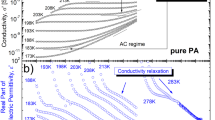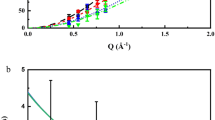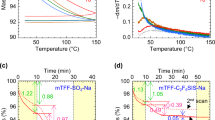Abstract
Neat liquid phosphoric acid (H3PO4) has the highest intrinsic proton conductivity of any known substance and is a useful model for understanding proton transport in other phosphate-based systems in biology and clean energy technologies. Here, we present an ab initio molecular dynamics study that reveals, for the first time, the microscopic mechanism of this high proton conductivity. Anomalously fast proton transport in hydrogen-bonded systems involves a structural diffusion mechanism in which intramolecular proton transfer is driven by specific hydrogen bond rearrangements in the surrounding environment. Aqueous media transport excess charge defects through local hydrogen bond rearrangements that drive individual proton transfer reactions. In contrast, strong, polarizable hydrogen bonds in phosphoric acid produce coupled proton motion and a pronounced protic dielectric response of the medium, leading to the formation of extended, polarized hydrogen-bonded chains. The interplay between these chains and a frustrated hydrogen-bond network gives rise to the high proton conductivity.
This is a preview of subscription content, access via your institution
Access options
Subscribe to this journal
Receive 12 print issues and online access
$259.00 per year
only $21.58 per issue
Buy this article
- Purchase on Springer Link
- Instant access to full article PDF
Prices may be subject to local taxes which are calculated during checkout




Similar content being viewed by others
References
DeCoursey, T. E. Voltage-gated proton channels and other proton transfer pathways. Physiol. Rev. 83, 475–579 (2003).
Wraight, C. A. Chance and design — proton transfer in water, channels and bioenergetic proteins. Biochim. Biophys. Acta 1757, 886–912 (2006).
Kreuer, K. D. Proton conductivity: materials and applications. Chem. Mater. 8, 610–641 (1996).
Kreuer, K. D., Paddison, S. J., Spohr, E. & Schuster, M. Transport in proton conductors for fuel-cell applications: simulations, elementary reactions, and phenomenology. Chem. Rev. 104, 4637–4678 (2004).
Marx, D. Proton transfer 200 years after von Grotthuss: insights from ab initio simulations. ChemPhysChem 7, 1848–1870 (2006).
Marx, D., Chandra, A. & Tuckerman, M. E. Aqueous basic solutions: hydroxide solvation, structural diffusion, and comparison to the hydrated proton. Chem. Rev. 110, 2174–2216 (2010).
Agmon, N. The Grotthuss mechanism. Chem. Phys. Lett. 244, 456–462 (1995).
Tuckerman, M. E., Marx, D., Klein, M. L. & Parrinello, M. On the quantum nature of the shared proton in hydrogen bonds. Science 275, 817–820 (1997).
Marx, D., Tuckerman, M. E., Hutter, J. & Parrinello, M. The nature of the hydrated excess proton in water. Nature 397, 601–604 (1999).
Tuckerman, M. E., Marx, D. & Parrinello, M. The nature and transport mechanism of hydrated hydroxide ions in aqueous solution. Nature 417, 925–929 (2002).
Vuilleumier, R. & Borgis, D. Transport and spectroscopy of the hydrated proton: a molecular dynamics study. J. Chem. Phys. 111, 4251–4266 (1999).
Schmitt, U. W. & Voth, G. A. The computer simulation of proton transport in water. J. Chem. Phys. 111, 9361–9381 (1999).
Markovitch, O. et al. Special pair dance and partner selection: elementary steps in proton transport in liquid water. J. Phys. Chem. B 112, 9456–9466 (2008).
Berkelbach, T. C., Lee, H.-S. & Tuckerman, M. E. Concerted hydrogen-bond dynamics in the transport mechanism of the hydrated proton: a first-principles molecular dynamics study. Phys. Rev. Lett. 103, 238302 (2009).
Woutersen, S. & Bakker, H. J. Ultrafast vibrational and structural dynamics of the proton in liquid water. Phys. Rev. Lett. 96, 138305 (2006).
de Grotthuss, C. J. T. Sur la décomposition de l'eau et des corps qu'elle tient en dissolution à l'aide de l'électricité galvanique. Ann. Chim. (Paris) LVIII, 54–74 (1806).
Marcus, R. A. On the theory of oxidation–reduction reactions involving electron transfer. I. J. Chem. Phys. 24, 966–978 (1956).
Kreuer, K. D. On the complexity of proton conduction phenomena. Solid State Ionics 136, 149–160 (2000).
Dellago, C., Naor, M. & Hummer, G. Proton transport through water-filled carbon nanotubes. Phys. Rev. Lett. 90, 105902 (2003).
Car, R. & Parrinello, M. Unified approach for molecular dynamics and density-functional theory. Phys. Rev. Lett. 55, 2471–2474 (1985).
Li, Q., Jensen, J. O., Savinell, R. F. & Bjerrum, N. J. High temperature proton exchange membranes based on polybenzimidazoles for fuel cells. Prog. Polym. Sci. 34, 449–477 (2009).
Boysen, D. A., Uda, T., Chisholm, C. R. I. & Haile, S. M. High-performance solid acid fuel cells through humidity stabilization. Science 303, 68–70 (2004).
Schuster, M., Rager, T., Noda, A., Kreuer, K. D. & Maier, J. About the choice of the protogenic group in PEM separator materials for intermediate temperature, low humidity operation: a critical comparison of sulfonic acid, phosphonic acid and imidazole functionalized model compounds. Fuel Cells 5, 355–365 (2005).
Westheimer, F. H. Why nature chose phosphates. Science 235, 1173–1178 (1987).
Heberle, J., Riesle, J., Thiedemann, G., Oesterhelt, D. & Dencher, N. A. Proton migration along the membrane-surface and retarded surface to bulk transfer. Nature 370, 379–382 (1994).
Tsuchida, E. Ab initio molecular-dynamics simulation of concentrated phosphoric acid. J. Phys. Soc. Jpn 75, 054801 (2006).
Vilciauskas, L., Paddison, S. J. & Kreuer, K. D. Ab initio modeling of proton transfer in phosphoric acid clusters. J. Phys. Chem. A 113, 9193–9201 (2009).
Greenwood, N. N. & Thompson, A. The mechanism of electrical conduction in fused phosphoric and trideuterophosphoric acids. J. Chem. Soc. 3485–3492 (1959).
Aihara, Y., Sonai, A., Hattori, M. & Hayamizu, K. Ion conduction mechanisms and thermal properties of hydrated and anhydrous phosphoric acids studied with 1H, 2H, and 31P NMR. J. Phys. Chem. B 110, 24999–25006 (2006).
Dippel, T., Kreuer, K. D., Lassègues, J. C. & Rodriguez, D. Proton conductivity in fused phosphoric acid: a 1H/31P PFG-NMR and QNS study. Solid State Ionics 61, 41–46 (1993).
Munson, R. A. Self-dissociative equilibria in molten phosphoric acid. J. Phys. Chem. 68, 3374–3377 (1964).
Janoschek, R., Weidemann, E. G., Zundel, G. & Pfeiffer, H. Extremely high polarizability of hydrogen bonds. J. Am. Chem. Soc. 94, 2387–2396 (1972).
Leuchs, M. & Zundel, G. Polarizable acid–acid and acid–water hydrogen bonds with H3PO2, H3PO3, H3PO4, and H3AsO4 . Can. J. Chem. 57, 487–493 (1979).
Komatsuzaki, T. & Ohmine, I. Energetics of proton transfer in liquid water. I. Ab initio study for origin of many-body interaction and potential energy surfaces. Chem. Phys. 180, 239–269 (1994).
Sharma, M., Resta, R. & Car, R. Dipolar correlations and the dielectric permittivity of water. Phys. Rev. Lett. 98, 247401 (2007).
Munson, R. A. Dielectric constant of phosphoric acid. J. Chem. Phys. 40, 2044–2046 (1964).
Buchner, R., Barthel, J. & Stauber, J. The dielectric relaxation of water between 0 °C and 35 °C. Chem. Phys. Lett. 306, 57–63 (1999).
Geissler, P., Dellago, C., Chandler, D., Hutter, J. & Parrinello, M. Autoionization in liquid water. Science 291, 2121–2124 (2001).
Blessing, R. H. New analysis of the neutron diffraction data for anhydrous orthophosphoric acid and the structure of H3PO4 molecules in crystals. Acta Cryst. B 44, 334–340 (1988).
Pomès, R. & Roux, B. Molecular mechanism of H+ conduction in the single-file water chain of the gramicidin channel. Biophys. J. 82, 2304–2316 (2002).
Hassanali, A., Prakash, M. K., Eshet, H. & Parrinello, M. On the recombination of hydronium and hydroxide ions in water. Proc. Natl Acad. Sci. USA 108, 20410–20415 (2011).
CPMD, version 3.13 (Max-Planck-Institut für Festkörperforschung and IBM Zurich Research Laboratory, 1995–2010).
Becke, A. D. Density-functional exchange-energy approximation with correct asymptotic behavior. Phys. Rev. A 38, 3098–3100 (1988).
Lee, C., Yang, W. & Parr, R. Development of the Colle–Salvetti correlation-energy formula into a functional of the electron-density. Phys. Rev. B 37, 785–789 (1988).
Troullier, N. & Martins, J. Efficient pseudopotentials for plane-wave calculations. Phys. Rev. B 43, 1993–2006 (1991).
Hohenberg, P. & Kohn, W. Inhomogeneous electron gas. Phys. Rev. 136, B864–B871 (1964).
Kohn, W. & Sham, L. Self-consistent equations including exchange and correlation effects. Phys. Rev. 140, A1131–A1138 (1965).
Spieser, S. A. H., Leeflang, B. R., Kroon-Batenburg, L. M. J. & Kroon, J. A force field for phosphoric acid: comparison of simulated with experimental data in the solid and liquid state. J. Phys. Chem. A 104, 7333–7338 (2000).
Martyna, G., Klein, M. & Tuckerman, M. Nosé–Hoover chains: the canonical ensemble via continuous dynamics. J. Chem. Phys. 97, 2635–2643 (1992).
Tuckerman, M. E., Berne, B. J., Martyna, G. J. & Klein, M. L. Efficient molecular dynamics and hybrid Monte Carlo algorithms for path integrals. J. Chem. Phys. 99, 2796–2808 (1993).
Wood, B. C. & Marzari, N. Proton dynamics in superprotonic CsHSO4 . Phys. Rev. B 76, 134301 (2007).
Hayes, R. L., Paddison, S. J. & Tuckerman, M. E. Proton transport in triflic acid hydrates studied via path integral Car–Parrinello molecular dynamics. J. Phys. Chem. B 113, 16574–16589 (2009).
Acknowledgements
L.V. acknowledges partial financial support from the EU FP6 Integrated Project ‘Autobrane’ and Stiftung Energieforschung Baden-Württemberg (FKZ A 23305). M.E.T. acknowledges support from the National Science Foundation (award no. CHE-1012545). The authors thank B. Frick (Institut Laue-Langevin, Grenoble) for valuable discussions and the Rechenzentrum Garching of the Max Planck Society for the use of computational resources.
Author information
Authors and Affiliations
Contributions
L.V., M.E.T., G.B., S.J.P. and K.D.K. designed the research. L.V., M.E.T. and G.B. performed AIMD simulations. L.V., M.E.T., G.B., S.J.P. and K.D.K carried out analysis. All authors discussed the results and contributed to preparation of the manuscript.
Corresponding authors
Ethics declarations
Competing interests
The authors declare no competing financial interests.
Rights and permissions
About this article
Cite this article
Vilčiauskas, L., Tuckerman, M., Bester, G. et al. The mechanism of proton conduction in phosphoric acid. Nature Chem 4, 461–466 (2012). https://doi.org/10.1038/nchem.1329
Received:
Accepted:
Published:
Issue Date:
DOI: https://doi.org/10.1038/nchem.1329
This article is cited by
-
A highly proton conductive perfluorinated covalent triazine framework via low-temperature synthesis
Nature Communications (2023)
-
Search for a Grotthuss mechanism through the observation of proton transfer
Communications Chemistry (2023)
-
Design and synthesis of phosphomolybdate coordination compounds based on {P4Mo6} structural units and their proton conductivity
Tungsten (2023)
-
Nanoporous nickel with rich adsorbed oxygen for efficient alkaline hydrogen evolution electrocatalysis
Science China Materials (2022)
-
MOFs in the time domain
Nature Reviews Chemistry (2021)



